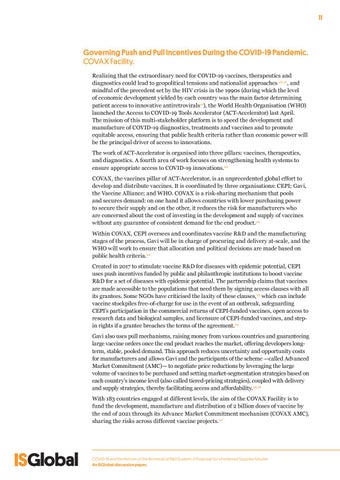11
Governing Push and Pull Incentives During the COVID-19 Pandemic. COVAX Facility. Realizing that the extraordinary need for COVID-19 vaccines, therapeutics and diagnostics could lead to geopolitical tensions and nationalist approaches 20,21, and mindful of the precedent set by the HIV crisis in the 1990s (during which the level of economic development yielded by each country was the main factor determining patient access to innovative antiretrovirals10), the World Health Organisation (WHO) launched the Access to COVID-19 Tools Accelerator (ACT-Accelerator) last April. The mission of this multi-stakeholder platform is to speed the development and manufacture of COVID-19 diagnostics, treatments and vaccines and to promote equitable access, ensuring that public health criteria rather than economic power will be the principal driver of access to innovations. The work of ACT-Accelerator is organised into three pillars: vaccines, therapeutics, and diagnostics. A fourth area of work focuses on strengthening health systems to ensure appropriate access to COVID-19 innovations.22 COVAX, the vaccines pillar of ACT-Accelerator, is an unprecedented global effort to develop and distribute vaccines. It is coordinated by three organisations: CEPI; Gavi, the Vaccine Alliance; and WHO. COVAX is a risk-sharing mechanism that pools and secures demand: on one hand it allows countries with lower purchasing power to secure their supply and on the other, it reduces the risk for manufacturers who are concerned about the cost of investing in the development and supply of vaccines without any guarantee of consistent demand for the end product.22 Within COVAX, CEPI oversees and coordinates vaccine R&D and the manufacturing stages of the process, Gavi will be in charge of procuring and delivery at-scale, and the WHO will work to ensure that allocation and political decisions are made based on public health criteria.22 Created in 2017 to stimulate vaccine R&D for diseases with epidemic potential, CEPI uses push incentives funded by public and philanthropic institutions to boost vaccine R&D for a set of diseases with epidemic potential. The partnership claims that vaccines are made accessible to the populations that need them by signing access clauses with all its grantees. Some NGOs have criticised the laxity of these clauses,23 which can include vaccine stockpiles free-of-charge for use in the event of an outbreak, safeguarding CEPI’s participation in the commercial returns of CEPI-funded vaccines, open access to research data and biological samples, and licensure of CEPI-funded vaccines, and stepin rights if a grantee breaches the terms of the agreement.24 Gavi also uses pull mechanisms, raising money from various countries and guaranteeing large vaccine orders once the end product reaches the market, offering developers longterm, stable, pooled demand. This approach reduces uncertainty and opportunity costs for manufacturers and allows Gavi and the participants of the scheme —called Advanced Market Commitment (AMC)— to negotiate price reductions by leveraging the large volume of vaccines to be purchased and setting market-segmentation strategies based on each country’s income level (also called tiered-pricing strategies), coupled with delivery and supply strategies, thereby facilitating access and affordability.25,26 With 183 countries engaged at different levels, the aim of the COVAX Facility is to fund the development, manufacture and distribution of 2 billion doses of vaccine by the end of 2021 through its Advance Market Commitment mechanism (COVAX AMC), sharing the risks across different vaccine projects.22
COVID-19 and the Reform of the Biomedical R&D System: A Proposal for a Preferred Supplier Model. An ISGlobal discussion paper.

